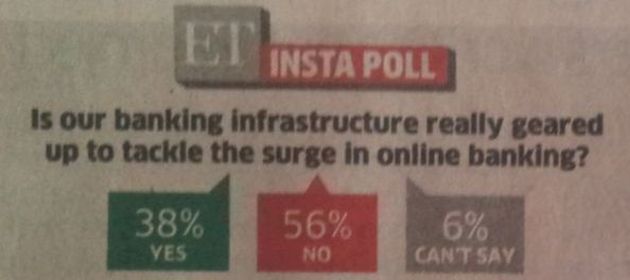On the back of the demonetization of high value currency notes in India, the government has been aggressively pushing cashless payments.
Trending on Twitter under the hashtag #CashlessIndia, the initiative has attracted criticism from the blogosphere and mainstream media on the grounds that India is not yet ready for digital payments. The average urban business-sensitive citizen seems to echo the same sentiment, judging by the results of the following poll conducted by Economic Times.
See MediaNama article titled Cash vs Digital Money: why going cashless is going to be tough in India for a comprehensive coverage of this point of view.
I don’t disagree with this viewpoint. In fact, I’d highlighted a few more hurdles to going cashless in my recent post PSA: Don’t Get Defensive About Not Going Cashless:
#5. Reluctance of Banks to Issue Merchant Accounts (aka POS Machines)
#6. Cash-Out Costs & Delays
#7. Card on Delivery Limitations
Attempting to drive cashless payments without overcoming these hurdles is a classic case of putting “the cart before the horse”, as Harvard Business Review observes.
Does it mean India should fix these fundamental issues first and only then attempt to go cashless?
No.
"Cashless Is Neither Possible Nor Desirable". A sensible statement that appears to be a U-turn if #CashlessIndia is interpreted literally. pic.twitter.com/zmSu7ApIKw
— GTM360 (@GTM360) January 3, 2017
Why not?
Because many of these issues are not really hurdles to go cashless at the present (low) level of cashless payments in India.
Besides, some of these hurdles won’t go away anytime soon.
Take infrastructure for example. Like physical infrastructure like roads, bridges, etc., network infrastructure also has a way of attracting more and more traffic until it becomes inadequate in a vicious cycle, reflecting the German proverb that translates to “The appetite grows as you eat”.
Even in the Bay Area, which is the de-facto Mecca of technology, network connections are patchy at times. Core banking, card management and other payment systems break down not so infrequently everywhere in the world, leading to failed payments.
That’s why waiting for 100% readiness of infrastructure to push digital payments is an exercise in futility. (I’ve always maintained that a robust business model is the real critical success factor for digital payments but that’s a blog post for another day).
Also because a certain degree of jugaad and leapfrogging of technologies has always been a part of the Indian DNA in several areas. For example:
- I once visited a village in Tamilnadu, a state in South India. This village got TV first, then got the electricity connection required to power the TVs! More on this experience in my blog post Putting the Cart Before the Horse Does Work!
- As the legend has it, doyens of the Indian IT industry set up their development centers in the Mariwala area of Bangalore in the early 1990s well before there was a paved road to access the facilities. It was only after they staged protests to call the attention of politicians to their employees’ plight that the local authority built proper roads in this neighborhood. Had they waited for infrastructure first, IT Services wouldn’t be a $140 billion business for India today.
IMO, we shouldn’t sacrifice our competitive advantage just to follow the traditional left-to-right, top-to-bottom approach towards nation building. Some degree of zig-zagging is fine.
Good news is, India can easily achieve 50% reduction in the use of cash without waiting to overcome the hurdles in front of digital payments. I say this on the basis of the following early indications in the last two months.
#1. Debit Card Activation
200 million out of the 755 million debit cards issued in India were activated only after the November 2016 demonetization.
What stopped them from being activated earlier?
#2. Card Promotion Campaigns
My bank ran an SMS campaign to promote card use two days after demonetization.
If only @HDFC_Bank had stimulated credit card usage in this manner all these years, we may not have needed #CurrencySwitch pic.twitter.com/ZT7tca5CKj
— Ketharaman Swaminathan (@s_ketharaman) November 10, 2016
Why did this bank have to wait for #CurrencySwitch to stimulate card use when it has been in the card issuing and merchant acquiring business for nearly 20 years?
 #3. If Vaishali Can, So Can Others
#3. If Vaishali Can, So Can Others
This iconic restaurant in Pune started accepting card payments within a week of #CurrencySwitch.
Why was it hung up on cash for 40+ years of its existence?
#4. Factory Workers Must Be Paid With Cheques
According to Times of India dated 12 December 2016, the Indian government has made it mandatory for wages of factory workers to be paid by cheques going forward.
When I read this, I was, like, duh?
I began my career as a Graduate Engineer Trainee in a factory in 1985. I got my first paycheck in cheque.
30 years later, why haven’t cheque – or the myriad other forms of cashless payments – become the go-to mode of payment of wages for factory workers?
#5. Newspaper Vendor Accepts Cheques
Enough of asking questions of others. It’s now time for some navel gazing.
I’ve been paying my newspaper vendor by cash for 10+ years. Prompted by the recent cash crunch, I asked him last month if I could pay him with some form of cashless payment. He nodded and pointed to a line in his bill that provides drawee details for cheque payments. I was shocked!
Why didn’t I notice before that he accepts cheques?
Cash is still legal tender. Personally I don’t see anything wrong if somebody wants to use cash.
However, the above examples do make it clear that a vast segment of the Indian population has shunned digital methods of payments only because “old habits die hard”.
I won’t comment on whether a democratic government has the moral authority to force its citizens to shed their old habits and foist a new payment behavior on them. Personally, I’ve no hassles with cash. I foresee that, in the immediate term, the switch to digital payments will cause a lot of chaos due to failed payments, identity theft and cyberfraud. I’m not one of those people that naively believes that cash implies malafide activity and noncash implies genuine activity.
But, the fact is, a democratically-elected government is pushing digital payments and people are not out on the streets protesting its cashless drive.
If we accept the reality as it is, the above early indications make me confident that demonetization alone will provide the required stimulus to pump up cashless payment volumes from the present 2% to at least 50% without doing anything to remove the fundamental hurdles to cashless adoption.
I’m not alone in saying this. According to the aforementioned HBR article:
Demonetization move is a welcome shock necessary to get a cash-intensive society weaned off its addiction and onto modern systems of digital payments.
-Harvard Business Review
It’s only to raise cashless payment volumes beyond 50% that the administration would need to overcome the fundamental hurdles to digital payments.
Ergo, putting the cart before the horse will work to drive #CashlessIndia – for now.


